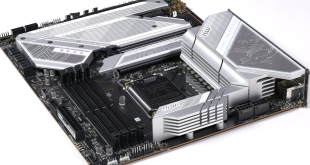It wouldn't be a Fatal1ty board without a picture of the man himself on the front of the box.
The box is a glorious gatefold design which opens up to reveal the life story of Fatal1ty and key selling points of the product design. You can also see the board in full glory thanks to a windowed panel.
The bundle is just what we would expect with a premium product – extensive. There is a well written user manual, software and driver disc, IDE and SATA cables, backplate, SLI connector, power converter cables and USB bracket.
The motherboard looks stunning, with the red ports a stark contrast to the black PCB and heatsink design.
The ASRock Fatal1ty board is sold with three PCI Express x16 slots and a single PCI Express x1 slot. There are also two standard PCI slots (controlled by an ASMedia ASM1083 bridge chip). The ASRock motherboard supports both SLI and CrossfireX configurations. There is a PLX PEX8608 processor on board which detects which devices are not being used to release the lanes for other components.
When a single graphics card is installed, the first slot works at x16 speed, however with two installed they defaults to x8/x8 speed. The third PCI Express x16 slot always works at x4 speed.
One of the talking points is the PCI Express 3.0 (Gen 3) support. Intel processors with the embedded PCI Express 3.0 controller will be the Ivy Bridge range, not yet released. The ASRock board uses NXP L04083B switch processors which will work with the next generation range from Intel and a compatible PCI Express 3.0 graphics card (also not yet released). The motherboard is certainly futureproofed for the upcoming technology.
The board is covered with an array of heatsinks to ensure that temperatures remain in check. ASRock are using Premium gold caps which are 100% Japan made solid capacitors, offering longer life and improved stability under load situations. The board also utilises a V12+6 CPU power phase which again is included for stability under overclocked situations. The voltage regulator uses a digital implementation with a CHiL CHL8328 controller.
The board is well designed with no noticeable PCB layout issues. There are three fan headers across corners of the board to accommodate a wide cross section of chassis design, although we would have liked to see a few more included on such a high level board. There is a power on and reset button on the board itself, alongside a two digit code readout to help with troubleshooting.
The board is supplied with 10 SATA ports which are horizontally mounted – meaning they won't cause problems for the longer graphics cards on the market, such as the HD6990. The Platform Controller Hub supports RAID 0,1,5 and 10 modes. Six of these ports are SATA 3 capable (6Gbps).
The I/O connectivity is first class and we were immediately pleased to see a RESET CMOS button for handy access. There is a special mouse port to allow the user to change the polling rate, ideal for gamers. We also appreciated the dual HDMI ports for multiple, digital output.
I/O Connectivity:
– 1 x PS/2 Keyboard Port
– 1 x VGA/D-Sub Port
– 2 x HDMI Ports
– 1 x Optical SPDIF Out Port
– 3 x Ready-to-Use USB 2.0 Ports
– 1 x Fatal1ty Mouse Port (USB 2.0)
– 1 x eSATA3 Connector
– 4 x Ready-to-Use USB 3.0 Ports
– 2 x RJ-45 LAN Ports with LED (ACT/LINK LED and SPEED LED)
– 1 x IEEE 1394 Port
– 1 x Clear CMOS Switch with LED
– HD Audio Jack: Rear Speaker / Central / Bass / Line in / Front Speaker / Microphone
 KitGuru KitGuru.net – Tech News | Hardware News | Hardware Reviews | IOS | Mobile | Gaming | Graphics Cards
KitGuru KitGuru.net – Tech News | Hardware News | Hardware Reviews | IOS | Mobile | Gaming | Graphics Cards













